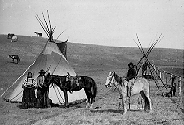


|
The People: A Historical Guide to the First Nations of Alberta,
Saskatchewan, and Manitoba.
Ward, Donald. Subject Heading:
Grades 8 and up / Ages 13 and up. ****/4
|

excerpt:
"The work is brief, and focuses primarily on the past three hundred years. During this period, all peoples had many elements in common, but there were as many, often subtler, points of difference. To speak of the horse coming to the Blackfoot is, in a sense, to speak of the horse coming to the Cree, the Assiniboine, the Sarcee, the Salteaux or the Shoshoni.... To describe the Cree hunting buffalo is to describe the Peigan, the Blood, the Dakota, or the Crow, but again, the manner in which this all important animal was integrated spiritually and conceptually with the people varied widely.... And if you begin to question who was affected by the fur trade, the answer must involve every sentient being within the boundaries of Manitoba, Saskatchewan, Alberta and beyond, and a billion fur-bearing animals besides."
Donald Ward knows his audience will be high-school students and Canadian history teachers. Yet, he does a strange and marvelous thing in The People: A Historical Guide to the First Nations of Alberta, Saskatchewan, and Manitoba. He does something so rarely seen that it is almost beyond comprehension; believe it or not, he actually writes for the people who are intended to read his book. Students' and teachers' eyes will be opened to a new appreciation of the First People of Canada because Ward's lucid and intelligent book is a pleasure to read.
The People looks at the diverse customs and social systems that made-up Native life and culture on the great western plains and woodlands. Ward discusses current archaeological-anthropological theory and evidence of North America's human habitation in a comprehensive introduction. The first half of the book is devoted to a study of the Assiniboine, the Blackfoot Confederacy, and the Nations of the Cree. The second half examines the smaller and more diverse peoples who also inhabit what is now Western Canada. He touches on virtually all aspects of Native life with a sensitive, yet critical, eye.

In his introduction and throughout the book, Ward challenges the simplicities, biases, and misunderstandings which fill the white historical record. Ward believes that the complex spiritual and secular cultures of the First Nations were denigrated and simplified by explorers, traders and missionaries. These misinterpretations have been perpetuated by generations of unsympathetic white chroniclers. However, Ward and many other Canadian historians, using ethnographic and anthropological methods, are beginning to appreciate the lives and history of First Nations' people in a more realistic and deserving way, without creating a destructive myth of a pristine primordial past.
There is a precarious balance between good scholarship and simply writing a book filled with anecdotal "factoids". Since students get their quota of boredom from teachers and textbooks, history books for young adults must be enjoyable without being trivial. Ward walks this line deftly, whether he is discussing the role of women, warrior societies, buffalo hunting, the funerary practices in Native societies or the treaties of the 1870s and 1880s. We feel satisfied but not overwhelmed by indigestible matter.
Besides writing a good book, Ward has added a bonus for the readers of The People. He has chosen photographs from Western Canadian archives and the National Archives of Canada that are not standard obligatory page fillers. I believe that he put some effort into choosing these intriguing images of our collective past. Readers will not only look at these pictures, they will study them and, with any luck, they will want more.
Highly Recommended
Ian Stewart works at Lord Nelson School in Winnipeg and at the University of Winnipeg Library.

To comment on this title or this review, send mail to cm@umanitoba.ca.
Copyright © 1996 the Manitoba Library Association. Reproduction for personal use is permitted only if this copyright notice is maintained. Any other reproduction is prohibited without permission.
Published by
The Manitoba Library Association
ISSN 1201-9364
AUTHORS |
TITLES |
MEDIA REVIEWS
BACK ISSUES |
SEARCH |
HOME